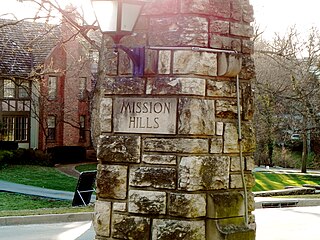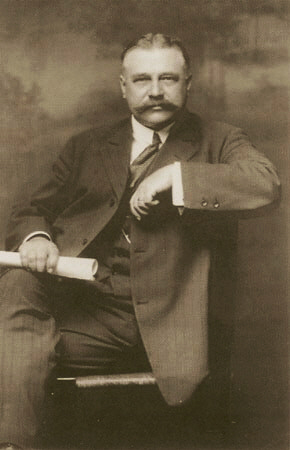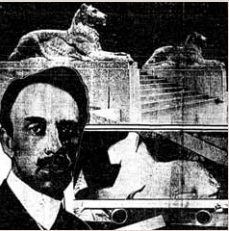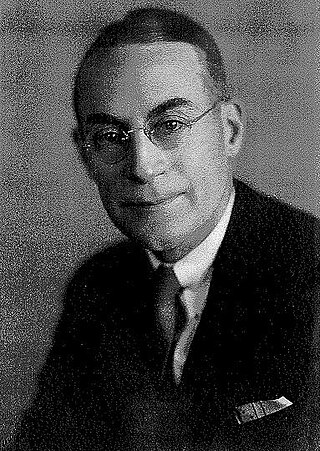Related Research Articles

Mission Hills is a city in Johnson County, Kansas, United States, and part of the Kansas City Metropolitan Area. As of the 2020 census, the population of the city was 3,594. The east city limits is the Kansas-Missouri state line at State Line Road. Mission Hills was originally developed by noted Kansas City developer J. C. Nichols beginning in the 1920s as part of his Country Club District plan.

Usonia is a word that was used by American architect Frank Lloyd Wright to refer to the United States in general, and more specifically to his vision for the landscape of the country, including the planning of cities and the architecture of buildings. Wright proposed the use of the adjective Usonian to describe the particular New World character of the American landscape as distinct and free of previous architectural conventions.

Jesse Clyde "J. C." Nichols was an American developer of commercial and residential real estate in Kansas City, Missouri. Born in Olathe, Kansas, and a student at the University of Kansas and Harvard University, his most notable developments are the Country Club District and Country Club Plaza in Kansas City, which influenced suburban developments in other parts of the United States. He served leadership roles in local and national real estate organizations. Through these organizations, his ideas about real estate and planning helped to shape methods for racist and anti-Semitic restrictive covenants and zoning. His legacy has come under increasing scrutiny for these covenants, which prohibited Blacks, Jews, and other minorities from living in these neighborhoods.

Thomas Theodore Crittenden was a United States colonel during the American Civil War, and a Democratic politician who served as the 24th Governor of Missouri from 1881 to 1885.
George Browne Post was an American architect trained in the Beaux-Arts tradition. He was recognized as a master of modern American architecture as well as being instrumental in the birth of the skyscraper.

Dr. John Alexander Low Waddell was a Canadian-American civil engineer and prolific bridge designer, with more than a thousand structures to his credit in the United States, Canada, as well as Mexico, Russia, China, Japan, and New Zealand. Waddell’s work set standards for elevated railroad systems and helped develop materials suitable for large span bridges. His most important contribution was the development of the steam-powered high-lift bridge. Waddell was a widely respected writer on bridge design and engineering theory, as well as an advocate for quality in higher education engineering programs. The company he founded in 1887, 'J.A.L. Waddell, Consulting Engineer,' would eventually become the modern day Hardesty & Hanover, a leading moveable bridge engineering firm. Many of Waddell's surviving bridges are now considered historic landmarks.

Pierre J. Lorillard IV was an American tobacco manufacturer and thoroughbred race horse owner.

George Edward Kessler was an American pioneer city planner and landscape architect.
Laurie Perry Cookingham, more commonly known as L.P. Cookingham or L. Perry Cookingham, was a noted public administrator in the United States having served as city manager of Kansas City, Missouri for 19 years. He also served as city manager of Clawson, Michigan, Plymouth, Michigan, Saginaw, Michigan and Fort Worth, Texas.

Jay Holcomb Neff was a newspaper publisher and Mayor of Kansas City, Missouri from 1904 to 1906.

Thomas Theodore Crittenden Jr. was the Mayor of Kansas City, Missouri from 1907 to 1910.

Eldridge Hirst Lovelace was an American city planner and author who prepared comprehensive plans for many large US cities.
Hare & Hare was a landscape architecture firm founded in Kansas City, Missouri, in 1910 by the father-and-son team of Sid J. Hare and S. Herbert Hare. A number of their works are listed on the National Register of Historic Places.
Perry Duke Maxwell was an American golf course architect. He was a founding member of the American Society of Golf Course Architects and was an inductee into the Oklahoma Sports Hall of Fame in 2012. He was known as the "father of Oklahoma golf".

Jørgen Christian Dreyer was a Norwegian-born American sculptor. He emigrated to the United States in 1903 and worked as a professor of sculpture at the Kansas City Art Institute from 1907 to 1909. In his career Dreyer created a number of monumental sculptures, some of which are located in Kansas City, Missouri. His major works include: Life Drift; The Goddess of Dawn; Sphinxes (pair); Biology and Chemistry ; Lionesses (pair); The Message ; Bust of Sir Carl Busch; Mercury, god of commerce; and Bust of Major General Sterling Price.

Henry Ford Hoit was a well-known Kansas City, Missouri, architect in the early 20th century. He and his partners designed many of Kansas City's most iconic commercial and residential buildings including the Kansas City Power and Light Building and the R.A. Long residence.

Robert James Raney was an American architect who worked for 20 years as the Chief Architect of the Fred Harvey Company system. He is notable for the work he did for Fred Harvey during those years, as well as numerous other projects before and afterward.
Sidney Herbert Hare, better known as S. Herbert Hare, was an American landscape architect and urban planner. Hare was the seventeenth president of the American Society of Landscape Architects.
Daniel Morgan Boone was the son of Daniel Boone and a significant American pioneer, explorer, and frontiersman in his own right. Daniel Morgan Boone was a particularly key player in the early American exploration and settlement of Missouri.

Forest Hill Calvary Cemetery is a cemetery in Kansas City, Missouri.
References
- 1 2 3 4 5 6 7 8 9 10 Coleman, Daniel (February 22, 2018). "Sid J. And S. Herbert Hare". pendergastkc.org. Archived from the original on October 8, 2022.
- 1 2 3 4 5 6 7 8 Coleman, Daniel. "Sid J. and S. Herbert Hare". Missouri Valley Special Collections. Retrieved March 13, 2017.
- 1 2 3 4 5 6 7 8 9 "Sid J. Hare is Dead". The Kansas City Star . October 26, 1938. p. 2. Retrieved October 8, 2022– via Newspapers.com.

- ↑ "National Register of Historic Places Registration Form: Horn-Vincent-Russell Estate". National Park Service. United States Department of the Interior. Retrieved March 11, 2017.
- ↑ "S. Herbert Hare". The Cultural Landscape Foundation. Retrieved March 13, 2017.
- ↑ "Architect Dies". Lubbock Morning Avalanche. October 27, 1938. p. 14. Retrieved October 8, 2022– via Newspapers.com.
